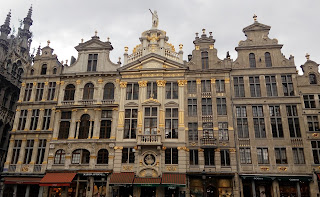I'm a Railway Child. I've grown up in railway colonies, played in railway clubs and moved wherever my father's Indian Railways job took him. I love trains - traveling in them, watching them chug past, railway stations, engines - everything about the railways fascinates me. I get very upset if people are critical about the Indian Railways - because once you experience the railway life, it gets into your blood and you are forever a Railway Child.
The Maeklong Railway is a 65km long, metre gauge line, that runs between Wongwian Yai, Bangkok, and Samut Songkhram in central Thailand. To the uninitiated a metre gauge line refers to the 1 metre width between two parallel railway tracks. There is about 95,000 km of railways in the world that still runs on metre gauge. In India, it is one of four types of railway gauges, although the metre gauge is fast disappearing due to extensive gauge conversion.
The Maeklong Railway in Thailand is a popular tourist spot, known as Talat Rom Hup in Thai, meaning the "umbrella pulldown market". The shops and stalls are literally an inch away from the railway track. Whenever a train is scheduled to pass, an alarm is sounded. The shop awnings etc are pulled back to let the train pass and then put out again. For this reason, the market is also known as Siang Tai or life risking market. To me it seemed like a metaphor of life itself, where the train represented significant happenings from which we take a step back, allow it to go past, and then resume our daily life again.
Maeklong is actually two pieces of history that are co-existing now. The market pre-dates the railway track, in existence since before the railways came to Thailand. It is one of the largest seafood markets in Thailand. Tourism websites note that despite being visited by thousands of tourists, it is still a fully local market selling seafood, meat, vegetables and other commodities - where seller and buyer are all local.According to our tour guide William, the track was built to supply the royalty with fresh sea food everyday. This, however, is likely to be a piece of fiction, as various websites suggest, that the railway was built for speedy delivery of fresh seafood to the provinces around the market, including Bangkok. (Although it is quite possible that the royal family got first dibs on the produce). The market remained where it was and the railway track simply cut through it, making it the popular tourist destination that it is today. I wish I could write more about the history of this local fresh food market itself. But most websites speak of it only in relation to the railway line that cuts through it.
The Maeklong Railway Line consists of two parts separated by the Tha Chin river. The first section consists of 20 stations and the second 15 stations. As there is no bridge connecting the two sections, at Mahachai station, one gets off, takes a ferry to the other side and then continues on by train to Samut Sonkhram on the Mae Klong river from where the line gets its name. It sounds so romantic to the leisurely traveller, where the journey is more enjoyable than the destination.
When I arrived here, at around 8am, I was not quite sure what to expect. The tour group walked up to the main Maeklong Railway station and were left free to wander around. The scene was no different than any typical Indian market - busy, bustling with activity. Vendors setting up their shops for the day, fresh produce being displayed. Flowers, fruits, vegetables and an assortment of sea food. I felt right at home and was happy to wander around, smiling at the women who called out to me to buy their wares. I got myself a cup of coffee just as the warning sounded for the approaching train. At astonishing speed the vendors rolled up their shop awnings, displays and shutters to make way for the approaching train. The teeming groups of tourists quickly flattened themselves on the side as the train slowly chugged past. Apparently it is one of the slowest trains in Thailand averaging a speed of only 30kmph and with no signals on the line. Just like everyone else, I whipped out my phone and videoed the train as it went past, stopping to wave at the grinning passengers inside the train.As the last coach trundled past, I wondered if there was an equivalent to this anywhere else in the world? What about our own India? Surely the Mumbai slums must have a train or two going through them? While not at 30kmph, it was slow enough to see people go about their 'morning business' along the tracks. Sometimes we even got to view some 'Crown Jewels' I thought with a smirk, as I boarded the coach for our next destination.
Another market, but a very unique one.
Note: All photographs posted here are taken by me.























